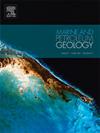水力压裂在水合物开发中的应用风险低估:基于地层变形和出砂的角度
IF 3.7
2区 地球科学
Q1 GEOSCIENCES, MULTIDISCIPLINARY
引用次数: 0
摘要
含水地层的水力压裂提高了储层渗透率,从而促进了产气,但同时损害了固体骨架的机械强度完整性,增加了储层变形、海底下沉和出砂的风险。尽管存在这些挑战,但水力压裂与这些风险之间的相互作用仍然没有得到充分的量化,导致开发风险被低估。在这项研究中,我们开发了一个完全耦合的热-水力-机械-化学模型,该模型包含出砂动力学,并通过实验数据和数值基准进行了验证。以神湖水合物储层为例,评价了水力压裂(裂缝长度为5 m,裂缝渗透率为1 D,损伤区渗透率为50 mD)对长期产气、地层变形和出砂行为的影响。分析表明,水力压裂可使累计产气量提高57%,1000天后可达2.34 × 106 m3。然而,压裂也会引发显著的力学退化:受损区域的体积应变超过2.5%,加剧了地层坍塌,导致海底下沉额外7厘米,总计21厘米,并使出砂量增加到903立方米,是未压裂产量的2.4倍。进一步增加裂缝长度超过5米或裂缝渗透率超过0.1 D,产气收益递减,但产砂加剧。将受损层的渗透率从25 mD提高到75 mD,可使产气量增加20%,但也会使出砂量增加49%,并使海底下沉4厘米。本文章由计算机程序翻译,如有差异,请以英文原文为准。
Underestimated risks for application of hydraulic fracturing into hydrate exploitation: In the perspective of formation deformation and sand production
Hydraulic fracturing in hydrate-bearing formation enhances reservoir permeability, thereby promoting gas production, but simultaneously compromises the mechanical strength integrity of the solid skeleton, amplifying risks of reservoir deformation, seafloor subsidence, and sand production. Despite these challenges, the interplay between hydraulic fracturing and such risks remains inadequately quantified, resulting in underestimation of exploitation risks. In this study, we developed a fully coupled thermal-hydraulic-mechanical-chemical model that incorporates sand production dynamics, validated against experimental data and numerical benchmarks. Using the Shenhu hydrate reservoir as a case study, we evaluated the effects of hydraulic fracturing (characterized by a fracture length of 5 m, a fracture permeability of 1 D, and a damage zone permeability of 50 mD) on long-term gas production, formation deformation, and sand production behaviors. Our analysis reveals that hydraulic fracturing increases cumulative gas production by 57 %, reaching 2.34 × 106 m3 after 1000 days. However, it also triggers significant mechanical degradation: the volumetric strain in the damaged zone exceeds 2.5 %, which exacerbates formation collapse, inducing an additional 7 cm of seafloor subsidence, for a total of 21 cm and intensifying sand production to 903 m3, 2.4 times higher than production without fracturing. Further increases in fracture length beyond 5 m or fracture permeability above 0.1 D yield diminishing returns in gas production but exacerbates sand production. Enhancing the damaged zone's permeability from 25 mD to 75 mD increases gas production by 20 %, but also raises sand production by 49 % and seafloor subsidence by 4 cm.
求助全文
通过发布文献求助,成功后即可免费获取论文全文。
去求助
来源期刊

Marine and Petroleum Geology
地学-地球科学综合
CiteScore
8.80
自引率
14.30%
发文量
475
审稿时长
63 days
期刊介绍:
Marine and Petroleum Geology is the pre-eminent international forum for the exchange of multidisciplinary concepts, interpretations and techniques for all concerned with marine and petroleum geology in industry, government and academia. Rapid bimonthly publication allows early communications of papers or short communications to the geoscience community.
Marine and Petroleum Geology is essential reading for geologists, geophysicists and explorationists in industry, government and academia working in the following areas: marine geology; basin analysis and evaluation; organic geochemistry; reserve/resource estimation; seismic stratigraphy; thermal models of basic evolution; sedimentary geology; continental margins; geophysical interpretation; structural geology/tectonics; formation evaluation techniques; well logging.
 求助内容:
求助内容: 应助结果提醒方式:
应助结果提醒方式:


